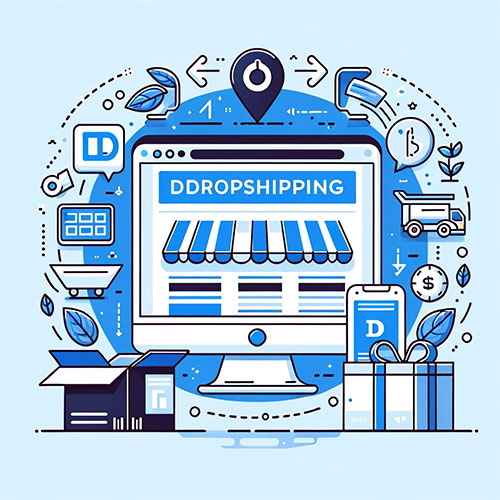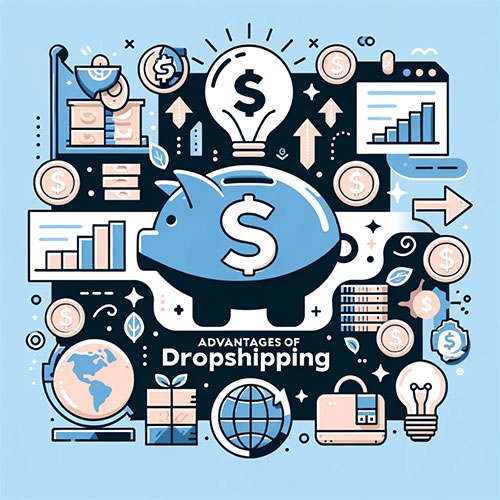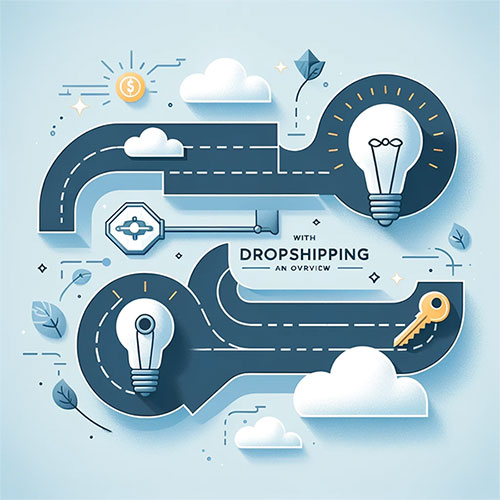What Is A Dropshipping Business

Introduction
Hey there! Ever wondered how that small online store you love manages to offer such a dizzying array of products without a warehouse the size of a football field? Well, the secret might just be dropshipping – a business model that’s revolutionizing the e-commerce world.
Imagine this: You’re browsing online for a quirky lamp to brighten up your workspace. You find one on a small, seemingly independent online store and place your order. Little do you know, this store doesn’t actually keep those funky lamps in stock. Instead, they’re using dropshipping, where the order you just placed is sent directly to a supplier who then ships the product to you. Neat, right?
Dropshipping is like being a middleman but in the coolest way possible. It’s about having a vast inventory without actually owning it. This model has allowed many entrepreneurs to start online businesses with minimal investment, democratizing the e-commerce landscape.
In this article, we’re diving deep into the world of dropshipping. Whether you’re a curious newbie, an aspiring entrepreneur, or just someone who enjoys a good business story, this piece will unravel the mysteries of dropshipping, showing you how it works, its perks, its challenges, and why it might just be the future of online retail.

The Basics of Dropshipping
So, what exactly is dropshipping? At its core, dropshipping is a streamlined form of retail business where the store owner doesn’t keep the products it sells in stock. Instead, when a store sells a product, it purchases the item from a third party and has it shipped directly to the customer. As a result, the seller never sees or handles the product.
A Different Retail Model
Unlike traditional retail, dropshipping doesn’t require a hefty investment in inventory. Traditional retailers buy products in bulk, store them, and then sell them to customers. Dropshipping skips the warehousing step entirely. This difference is what makes dropshipping a game-changer, especially for small or startup businesses.
Key Components of a Dropshipping Business
- Supplier Relationships: A dropshipping store relies heavily on its relationships with suppliers. These are the folks who create, store, and ship products. Good suppliers are the backbone of a successful dropshipping business.
- E-commerce Platform: This is where the magic happens. Platforms like Shopify, WooCommerce, or Etsy are where dropshippers set up shop, list products, manage sales, and interact with customers.
- Niche Selection: The best dropshipping stores often focus on a specific niche or type of product. This focus helps in building a brand and attracting a targeted customer base.
In summary, dropshipping is a unique retail model that avoids the traditional need for inventory management. It relies on strong supplier relationships, effective use of e-commerce platforms, and a well-chosen niche market.

The Dropshipping Process
Understanding the dropshipping process is key to grasping how this business model stands out.
Here’s a step-by-step breakdown of how it typically works:
Step-by-Step Breakdown
- Customer Places an Order: It all starts when a customer places an order on your online store. They pick out a product they love, make a payment, and await its arrival.
- Order is Forwarded to the Supplier: Instead of heading to a warehouse to get the product, you, the store owner, send the order details to your supplier. This is often done automatically through integrated e-commerce platforms.
- Supplier Ships the Product: Upon receiving the order information, the supplier packages and ships the product directly to the customer. You’re not involved in the handling or shipping process, which saves you a ton of time and hassle.
- Customer Receives the Product: The customer receives the product with your store’s branding and packaging, completely unaware of the third-party supplier’s involvement.
Role of the Dropshipper
As the dropshipper, your primary role is to manage the online storefront and customer relations. This involves:
- Product Curation: Selecting the right products to list on your store.
- Marketing and Sales: Promoting your store and products to attract customers.
- Customer Service: Handling customer inquiries, complaints, and returns.
This process highlights the efficiency of dropshipping. It allows you to run an e-commerce store without dealing with physical products, while still maintaining a strong brand presence and customer relationship.

Advantages of Dropshipping
Dropshipping isn’t just a buzzword; it’s a business model with tangible benefits, especially for those looking to dive into e-commerce without a massive upfront investment. Here’s why it’s such a hot topic:
Low Startup Costs and Minimal Overhead
- Minimal Initial Investment: You don’t need to invest thousands in inventory upfront. Instead, you only purchase a product when you’ve already made the sale and have been paid by the customer.
- No Warehouse Costs: Since you’re not handling the physical products, there’s no need for storage space, which cuts down on rental costs significantly.
Flexibility and Scalability
- Work from Anywhere: All you need is a laptop and an internet connection. Whether you’re at a beach café or your dining table, your store goes where you go.
- Easy to Scale: With traditional retail, more sales mean more work in stocking and shipping. In dropshipping, much of this is handled by suppliers, making it easier to grow.
Wide Range of Products Without Inventory Concerns
- Vast Selection: You can offer a broad array of products without ever worrying about physical space.
- Test Products Easily: Want to test a new product category? You can add it to your store without any risk of unsold inventory.
These advantages make dropshipping a particularly attractive model for first-time entrepreneurs and those looking to test the e-commerce waters without diving headfirst into significant financial commitments.

Challenges and Considerations
While dropshipping offers numerous advantages, it’s not without its challenges. Being aware of these is crucial for anyone considering this business model. Let’s unpack some of the key hurdles and important considerations:
Dealing with Supplier Issues and Inventory Shortages
- Reliance on Suppliers: Your reputation can hinge on your suppliers. Issues like shipping delays, stock shortages, and product quality are largely out of your control but directly impact your customer satisfaction.
- Inventory Transparency: Since you don’t handle the inventory, keeping track of what’s in stock can be tricky, potentially leading to situations where you sell products that are actually unavailable.
Choosing the Right Niche and Products
- Market Saturation: Popular niches can be oversaturated, making it hard to stand out. Finding a balance between popularity and uniqueness is key.
- Product Quality and Consistency: Since you don’t see the products yourself, ensuring consistent quality can be challenging.
Challenges with Customer Service and Returns
- Customer Service: Handling customer queries and issues is entirely in your court. Excellent customer service is vital to compensate for the lack of physical interaction.
- Return and Refund Processes: Returns can be more complicated. You’ll need clear policies and good coordination with your suppliers to handle returns smoothly.
These challenges underscore the importance of thorough research and planning in dropshipping. Choosing reliable suppliers, selecting the right niche, and being prepared to handle customer service excellently are critical to the success of a dropshipping business.
Certainly! Let’s expand on the final section with more detail:

Getting Started with Dropshipping: An Overview
Embarking on a dropshipping journey can be exhilarating, but knowing where to start is crucial. Here’s a more detailed guide to help you lay the groundwork for a successful dropshipping business:
In-Depth Market Research
- Identifying Your Niche: Dive deep into market research to find a niche that not only interests you but also has a strong customer base. Tools like Google Trends, social media analytics, and competitor analysis can offer insights into what’s trending and what gaps you can fill.
- Understanding Your Audience: Learn about your potential customers. What are their interests, buying behaviors, and pain points? This knowledge will guide your product selection and marketing strategies.
Finding and Vetting Suppliers
- Platforms for Supplier Discovery: Explore platforms like AliExpress, Oberlo, SaleHoo, or Doba. These platforms offer a wide range of suppliers and products.
- Evaluating Suppliers: Look for suppliers with high ratings and positive reviews. Consider factors like product quality, shipping times, and reliability. Establishing communication with suppliers before partnering is crucial to gauge their responsiveness and support.
Choosing the Right E-commerce Platform
- Platform Options: Research platforms like Shopify, WooCommerce, and BigCommerce. Each has its strengths – Shopify is known for its ease of use, WooCommerce for its customization with WordPress, and BigCommerce for handling larger product catalogs.
- Integration with Dropshipping Tools: Check the platform’s compatibility with dropshipping tools and apps. Many platforms offer integrations with dropshipping suppliers, making the process more seamless.
Crafting Your Marketing and Branding Strategy
- Building Your Brand: Create a compelling brand story and identity. This includes your brand name, logo, and the overall look and feel of your store.
- Digital Marketing Tactics: Utilize SEO (Search Engine Optimization) to improve your online visibility. Leverage social media marketing, content marketing, and email marketing to engage with your audience and drive traffic to your store.
- Paid Advertising: Consider using paid advertising like Google Ads or social media ads to reach a wider audience. Target your ads based on your audience research.
Setting Up Your Online Store
- Store Design: Design a store that’s not only visually appealing but also user-friendly. Ensure it’s easy to navigate, has clear product descriptions, and a smooth checkout process.
- Customer Service Plan: Develop a solid plan for customer service. This includes clear policies on shipping, returns, and refunds, and a system for handling customer inquiries and complaints.
By following these steps, you’ll be better prepared to launch your dropshipping business with a solid foundation. Remember, the key to success in dropshipping lies in thorough research, a strong relationship with suppliers, a well-thought-out platform choice, and an effective marketing strategy.
Great! Let’s wrap up the article with the conclusion and additional resources:
Conclusion
Diving into the world of dropshipping is an intriguing venture that combines the excitement of entrepreneurship with the practicalities of e-commerce. While it presents a unique set of challenges, from supplier reliability to market saturation, the potential rewards are significant. With low startup costs, flexibility, and access to a global market, dropshipping offers an appealing path for aspiring business owners.
As you embark on this journey, remember that success in dropshipping hinges on strategic planning, careful product and niche selection, and exceptional customer service. The dropshipping landscape is dynamic, requiring continuous learning and adaptation.
Additional Resources from Dropship News
For further insights and tools to navigate the dropshipping business, check out these articles from Dropship News:
- The Dropshipping Business: A Step-by-Step Guide for Beginners – A comprehensive guide to help you start your dropshipping journey.
- Shopify’s One-Page Checkout – Conversions Drop By 80% – Understand how changes in e-commerce platforms can impact your dropshipping business.
- The Dropshipping Gurus Are Lying To You! – Insights into some of the myths and truths in the dropshipping world.
Leveraging these resources will provide you with a solid foundation and ongoing guidance as you build and grow your dropshipping business.





